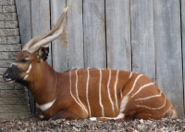 The Bongo (Tragelaphus eurycerus) is an antelope species that can be found in certain parts of Africa. The Bongo is the heaviest and largest forest antelope. The animal is usually reddish orange in color with about 10-15 distinct vertical white stripes. The coat color will grow darker as the animal ages. The animal has a black muzzle with a white cheek spots.
The Bongo (Tragelaphus eurycerus) is an antelope species that can be found in certain parts of Africa. The Bongo is the heaviest and largest forest antelope. The animal is usually reddish orange in color with about 10-15 distinct vertical white stripes. The coat color will grow darker as the animal ages. The animal has a black muzzle with a white cheek spots. One of the unique features of the Bongo antelope is that it is one of only animal species in the world where horns can be found on both male and female sexes. The Bongo's horns can grow up to 75-100 cm long and can be a bit wavy in appearance. Horns of females are usually longer, thinner and more parallel.
Dimensions
Length: 5.6-8.3 ft. or 170-250 cm
Shoulder Height- 3.6 to 4.3 ft. or 110-130 cm
Tail Length- 18 to 26 in. or 45 to 65 cm
Weight- 525 to 880 lb. or 240 to 400 kg
Animal Behavior
The Bongo is a solitary and shy animal that usually move in singles or small pair groups. An average sized group may consist of about 9 or less females with their young. If startled, the Bongo will quickly flee into the forest. When running, Bongo horns are held back to prevent them from tangling with the vegetation.
Habitat
Bongos can be found in the dense African forests or jungles with altitudes of about 4,000 meters of central Africa. There is a little population in Kenya and some other West African countries. Countries where Bongos live include Cameroon, Burkina Faso, Congo, DRC, Equatorial Guinea, Gabon, Guinea, Ghana, Mali, Sierra Leone, Liberia, Ethiopia, Cote d'Ivoire, Sudan, Niger and Guinea-Bissau. Kenya is the only country where the animal can be found in the wild.
Diet
Bongos are herbivores and their diet consist of bushes, trees, barks, vines, rotting trees, herbs, grasses, cereals, fruits, shrubs and roots. As nocturnal animals they usually graze during the night. The animal has a prehensile tongue that allows it feed off easily from high vegetations.
At present, the Bongo is regarded as a threatened animal with dwindling numbers. Deforestation and hunting has greatly reduced their numbers. The animal is already reportedly considered to have gone extinct in three African countries, which are Uganda, Togo and Benin.
Keywords: nocturnal , brown , black , white , yellow , stripe , horn
Which zoos have them?
Los Angeles Zoo (United States)The Bongo is listed as Near Threatened (LR/nt), is close to qualifying for or is likely to qualify for a threatened category in the near future, on the IUCN Red List of Threatened Species
Countries
Angola, Burkina Faso, Cameroon, Central African Republic, Congo, Democratic Republic of the, Congo, Republic of the, Cote d'Ivoire, Equatorial Guinea, Ethiopia, Gabon, Ghana, Guinea, GuineaBissau, Kenya, Liberia, Mali, Niger, Sierra Leone, Sudan, Togo and UgandaSome facts about the
Bongo
Adult weight : 307.5 kg (676.5 lbs)
Maximum longevity : 22 years
Female maturity :806 days
Male maturity : 914 days
Gestation : 288 days
Litter size : 1
Litters per year : 1
Weight at birth : 19.8 kg (43.56 lbs)

Custom Search